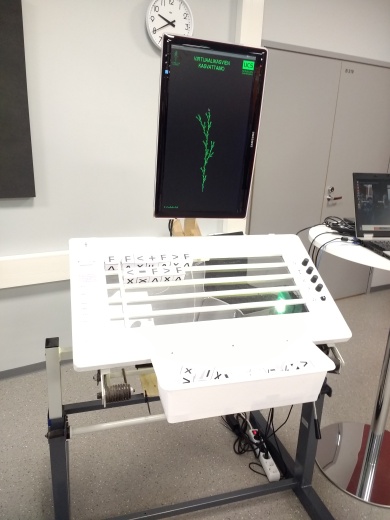Source code for an L-system visualziation & installation / demo. It uses physical blocks with symbols and OCR to define the L-system and a PC and a TV screen to display the plant/fractal generated by those rules.
To build one you need to get and build following things:
- At least 24 blocks with following symbols
F,X,+,-,[, and]. I used plastic 40x40mm blocks from kids puzzle with letters<and>instead of[and]to make OCR to work better. - A custom made table with a part of the table top being transparent. Preferably there are slots where the blocks fit with some slack.
- 4 potentiometers and one on/off type switch and an Arduino to read the values and send the readings to the PC via USB-serial. Source code for the Arduino is in
lsystem_pots. - First pot adjusts how many rewrite iterations are applied with the current set of rules.
- Second pot adjusts the length of each
Fdraw command. - Third pot adjusts the angle of
-and+commands. - Fourth pot adjusts the strength of the wind effect.
- A PC with Python 2.7, PyGame, OpenCV and Arduino IDE installed. I used Ubuntu Linux 16.04 LTS.
- A monitor or a flat TV and some way of fixing it in portrait mode.
- USB webcam and a light source and a adjustable mount to hold it them position under the table. I used PS3 PlayStation Eye camera and an 220V LED spot.
Unfortunately I have no detailed plans, but feel free to consult following photo.
There are three Python scripts in the repository:
l-system.pywhich is the main application. It opens a PyGame window to display the plant, reads the parameter values from the USB-serial and can be used to control the application.- Keys
[ESC]and[Q]exit the application. - Keys
[1]to[7]intialize one of the predefined L-Systems. - Key
[M]reads a L-System from a filemanual_rules.txt. Can be used to override the recognized system if OCR fails. - Key
[P]takes a picture using the webcam, saves it on the disk and and detects the symbols on the table using the funcionality inread_ocr.py. - Also toggling the button connected to the Arduino will send a command which takes a picture and tries to recognize the system from it.
- Key
[S]reintializes the serial communication.
- Keys
read_cam.pycan be used to position the camera. Just continuously grabs images from the webcam.train_ocr.pyis used to label the data intrainingdatafolder for training OCR classifiers. Please take care to adjustMAX_CHAR_SIZE_IN_PIX,MIN_CHAR_NARROW_SIZE_IN_PIX, andMIN_CHAR_WIDE_SIZE_IN_PIXconstants to fit your setup.[ESC]stops training and stores the data files in the working directory, here they can be transferred to alabeled_datafolder. Use following keys for the block symbols:n= not a symbol (glitch)9=>or]8=<or[i=|/-p=+f=Fe= upsidedownFx=Xz=Xrotated 90 degrees
read_ocr.pyoffers the OCR recognition funcitionality. It builds a classifier model and applies it when asked to detect symbols from an image. If run as a script OCRs the images in theimg_source_folder. The recognized characters can then be interpreted as starting condition and rules.
X : F<+X>-X
F : FF
X : F-<+X>+F<+FX>-X
F : FF
F : F<+F>F<-F>F
F : F<+F>F<-F>
F : FF-<-F+F+F>+<+F-F-F>
X : F<+X>F<-X>+X
F : FF
X : F<+X><-X>FX
F : FF
